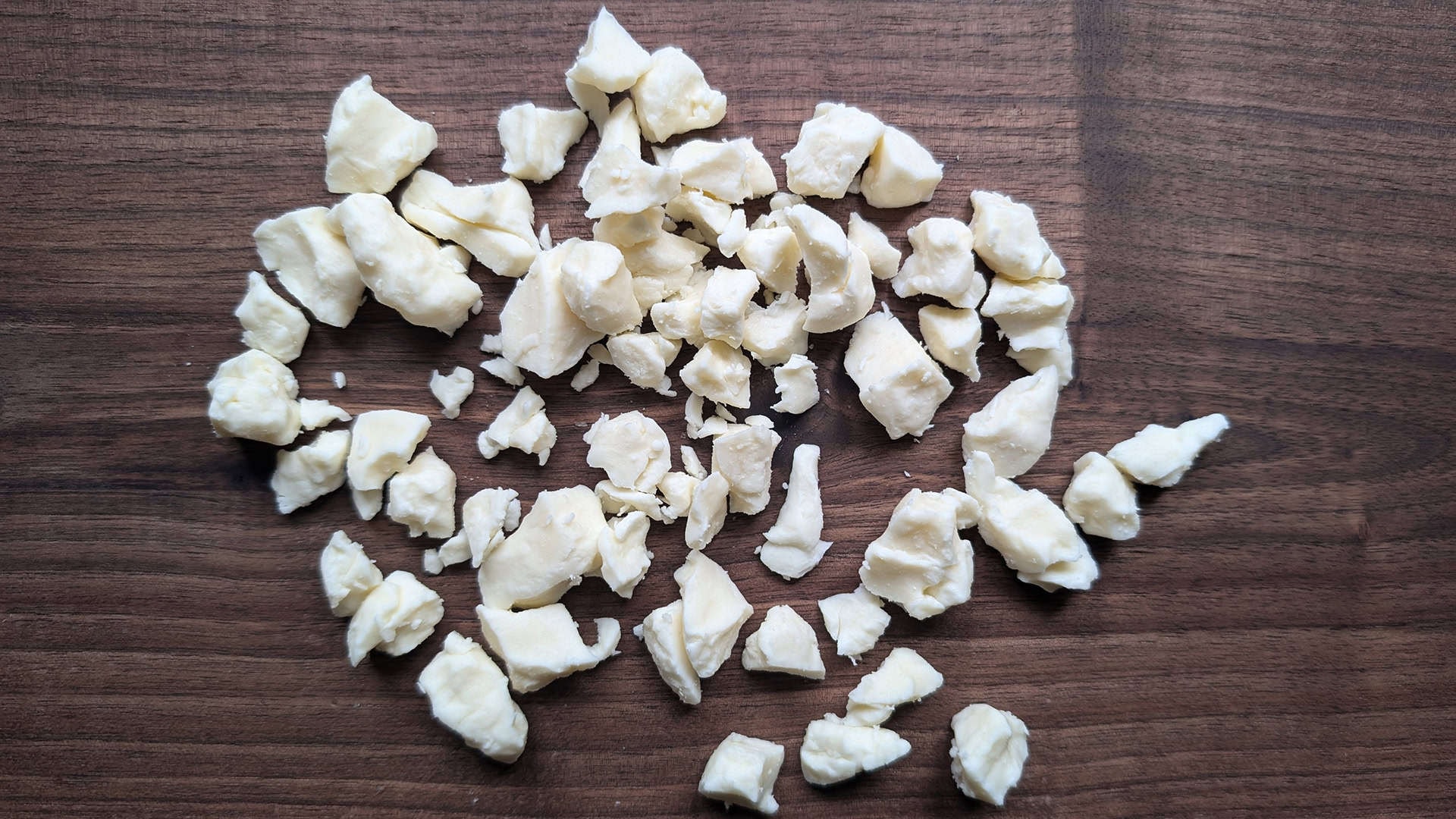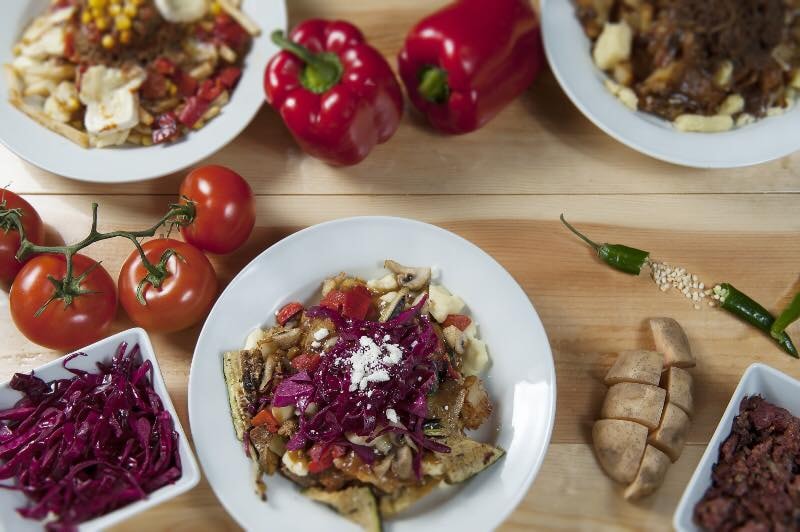In this article, you will find information about Poutine:
Poutine is a savory Canadian dish made with French fries, cheese curds, and gravy. Originating in Quebec during the 1950s, it has become a national favorite. This guide explores its ingredients, variations, and how to make the perfect poutine at home.
Key Takeaways
Poutine is a classic Canadian dish made of crispy French fries, fresh cheese curds, and hot gravy, originating in Quebec during the 1950s.
Quality ingredients are crucial for authentic poutine, with thick-cut russet potatoes for fries, fresh white cheddar cheese curds, and a rich gravy made from beef and chicken broth.
Poutine is versatile and can be customized to cater to different dietary needs, including vegetarian, vegan, gluten-free, and keto options.
History of Poutine
Poutine’s origins are shrouded in delicious mystery and lively debate. This iconic Canadian dish hails from Quebec, where it first appeared in the 1950s. The exact details of its invention are contested, but most agree that the combination of fries, cheese curds, and gravy was born out of a desire for a hearty, satisfying meal.
Several small-town Quebec restaurants claim to be the birthplace of poutine. One popular tale credits Fernand Lachance of Le Lutin Qui Rit in Warwick, Quebec, who allegedly exclaimed, “Ça va faire une maudite poutine!” (“It will make a damn mess!”) when asked to add cheese curds to a customer’s fries. Another story points to Jean-Paul Roy of Le Roy Jucep in Drummondville, who claims to have served the first poutine with gravy in 1964.
Regardless of its exact origin, poutine quickly became a beloved dish throughout Quebec and eventually all of Canada. It has since evolved into a culinary symbol of Canadian culture, with countless variations and adaptations enjoyed worldwide.
What Is Poutine?

Poutine is a beloved Canadian dish consisting of French fries topped with fresh cheese curds and smothered in hot gravy. It is often improved with various toppings, adding even more flavor and texture to this already delicious dish. This combination creates a harmonious blend of textures and flavors that make it an irresistible comfort food. The essential ingredients are straightforward: crispy French fries, squeaky cheese curds, and rich, flavorful gravy. But what makes authentic canadian poutine truly special is its deep cultural roots and the pride it evokes among Canadians.
Originating in Quebec in the 1950s, poutine has grown from a regional specialty to an internationally recognized symbol of Canadian cuisine. The pronunciation of ‘poutine’ varies, with English Canadians typically saying ‘poo-teen,’ while in Quebec, it’s pronounced ‘poo-tin’. Regardless of how you say it, poutine’s deliciousness transcends linguistic boundaries, making it a staple in Canadian restaurants and homes alike.
The Essential Ingredients of a Poutine
At its core, poutine is a simple dish made extraordinary by its components. The essential ingredients are French fries, fresh cheese curds, and hot gravy. Each element plays a crucial role in achieving the perfect poutine, and quality ingredients make all the difference in the final dish.
The French fries should be crispy on the outside and fluffy on the inside, providing the perfect base. Fresh cheese curds, known for their distinctive squeaky texture, are a must. When covered with hot gravy, these curds soften slightly but maintain their shape, creating a delightful contrast in every bite. The gravy, typically a rich, brown sauce made from butter, flour, and broth, ties everything together with its savory depth.
There are countless variations of poutine gravy, from classic beef gravy to more adventurous options like spicy or BBQ gravies. While traditional poutine sticks to white cheese curds, you can experiment with different types of cheeses to suit your taste. No matter how you choose to customize your poutine, ensuring each ingredient is of the highest quality is key to making the best poutine recipe.
The Perfect French Fries
French fries are the backbone of any great poutine, and achieving the perfect fry is an art in itself. The key to excellent poutine fries is choosing thick-cut fries, which provide the best texture and hold up well under the weight of cheese curds and gravy. Avoid matchstick-shaped fries as they tend to become soggy.
Creating homemade fries requires patience and attention to detail. Slice the potatoes uniformly to a thickness of about 1/2-inch for even cooking. Here’s how to choose the right potatoes and master the frying techniques to achieve those golden, crispy fries.
Choosing the Right Potatoes

When it comes to making the best poutine fries, russet potatoes are your best bet. These potatoes have a high starch content, which is crucial for achieving extra crispy fries. Before frying, soak the sliced potatoes in cold water for at least two hours, or preferably overnight, to remove excess starch. This step is vital for ensuring that your fries turn out crispy rather than soggy.
You can choose to peel the potatoes or leave the skins on for added texture.
At Poutineville, we always use fresh potatoesto make our homemade French fries and cook them daily to ensure the highest quality. Once soaked, rinse the potatoes thoroughly and pat them dry before moving on to the frying stage.
Frying Techniques
Deep frying is the secret to achieving perfectly crispy French fries. Using a proper deep fryer ensures even cooking and helps maintain the ideal texture. After soaking and drying the potatoes, heat your oil to 275°F for the first frying stage. Fry the potatoes in batches until they are soft and lightly golden. This step is crucial for cooking the potatoes through without burning them.
After the fries have cooled, heat the oil to 375°F for the second frying stage. Fry the potatoes again for 3-5 minutes until they are golden brown and crispy. Canola oil, with its neutral flavor and high smoke point, is a popular choice for frying, though vegetable or peanut oil also works well.
At Poutineville, dedicated fryers are used to guarantee gluten-free and perfectly crispy fries.
Fresh Cheese Curds

Cheddar cheese curds play a starring role in poutine. They are the highlight of this dish. These small lumps of fresh cheese have a unique texture that squeaks when bitten into, earning them the nickname ‘squeaky cheese’. Cheese curds are made by separating the cream from the liquid whey during the cheese-making process.
For the best poutine, it’s essential to use fresh cheese curds, preferably white cheddar curds, which are highly favored in traditional Canadian poutine. When hot gravy is poured over them, they soften slightly but maintain their shape, creating a delightful contrast with the crispy fries. You can find cheese curds specifically made for poutine in grocery stores, often labeled as ‘poutine cheese curds’.
Authentic Poutine Gravy
The gravy is what ties the entire poutine dish together, adding a rich, savory depth that complements the fries and cheese curds. While you can purchase pre-made poutine gravy from the grocery store, making your own can elevate the dish to new heights. At Poutineville, we offer a variety of gravies, each with its unique flavor profile, from classic to spicy and BBQ gravies.
Creating authentic poutine gravy involves using a combination of beef broth and chicken broth. The ideal ratio is 2/3 beef broth to 1/3 chicken broth, seasoned with freshly ground pepper and a splash of Worcestershire sauce.
Here’s how to make homemade poutine gravy.
Homemade Poutine Gravy
To make a delicious poutine gravy, start by melting unsalted butter in a saucepan. Add flour to create a roux, cooking until it’s lightly browned. Gradually whisk in beef stock and chicken stock, maintaining the 2/3 to 1/3 ratio. Add a splash of Worcestershire sauce and season with freshly ground pepper to taste.
Simmer the gravy until it thickens to your desired consistency. This homemade gravy will be rich and flavorful, perfectly complementing the crispy fries and squeaky cheese curds.
With the gravy ready, it’s time to assemble and serve your poutine masterpiece.
Assembling and serving Poutine

Assembling poutine is an art that requires timing and precision. Start by reheating your gravy until it’s hot and ready to pour. Once your fries are golden and crispy, season them lightly with salt while they are still warm. Place the fries in a bowl and top them with fresh cheese curds.
Drizzle the hot gravy over the fries and cheese curds, ensuring everything is well-coated. Gently toss the poutine with tongs to distribute the gravy evenly. Serve immediately to enjoy the best texture and flavor.
If the gravy becomes too thick, add a splash of broth to thin it out. Remember, poutine is best enjoyed fresh and hot.
Variations of Poutine

Poutine has come a long way from its humble beginnings, with countless variations now available to suit different tastes and preferences. Popular variations include Pulled Pork Poutine, which features slow-cooked pork and tangy barbecue sauce for a gourmet twist on the classic. Other creative takes include Montreal’s smoked meat poutine and veggie poutine, which incorporates a variety of fresh, roasted vegetables.
At Poutineville, we offer a plethora of toppings and sauces, allowing you to customize your poutine with ingredients like jalapeños, mushrooms, and different cheeses.
Where to Find Cheese Curds
Finding fresh cheese curds is essential for making authentic poutine. Many grocery stores, including Walmart, carry white cheese curds suitable for poutine. Specialty cheese shops and local cheese factories are also excellent sources for fresh cheese curds, often selling them the same day they are made.
In the deli section of stores like Sprouts and Whole Foods, you can typically find cheese curds. It’s important to use cheese curds that are fresh and at room temperature for the best texture and squeakiness. Use the curds within 24 hours of purchase for optimal results.
Tips for the Best Poutine
To achieve the best poutine, timing and quality are everything. Serve the poutine immediately after assembling to maintain the ideal texture of crispy fries and squeaky cheese curds. If left sitting, the fries can become soft, compromising the dish’s signature crunch.
Enhance the flavor of your poutine by adding freshly ground pepper just before serving. This simple addition can make a big difference in the overall taste. Remember, the key to the best poutine is using fresh, high-quality ingredients and serving it hot.
Storing and Reheating Leftovers
While poutine is best enjoyed fresh, there are ways to store and reheat leftovers effectively. Gravy can be refrigerated for three to four days when stored in an airtight container. It’s crucial to keep the components separate to maintain the integrity of the fries and cheese curds.
For those who like to prepare in advance, components of poutine can be prepped ahead of time. Here’s how to do this effectively.
Preparing Ahead
Preparing components of poutine in advance can save time and ensure you can enjoy this delicious dish whenever you like. You can fry the potatoes first. After that, freeze them for later use.
This way, you only need to reheat the fries and prepare the gravy when you’re ready to serve.
Freezing and Reheating
For the best results, use an air fryer to reheat leftover fries, as it helps retain their crispiness. Once assembled, poutine should not be frozen, as the fries will become soggy. However, you can freeze the individual components, such as gravy and cheese curds, for future use.
Meat-based gravy can be frozen for four to six months without losing quality. When reheating, ensure the gravy is hot and pour it over freshly reheated fries and thawed cheese curds for the best experience.
Poutine for different diets or life style
Poutine is a versatile dish that can be adapted to fit various dietary requirements, making it accessible for everyone. Whether you’re vegetarian, vegan, gluten-free, or following a keto diet, there’s a version of poutine for you.
Here are some adaptations in detail.
Keto Poutine

For those following a ketogenic diet, traditional potato fries can be substituted with low-carb alternatives like celeriac or turnip fries. These vegetables provide a similar texture and flavor to potato fries while keeping the carb count low. Check out our detailed guide on Keto Poutine for more tips and recipes.
At Poutineville, some locations offer celeriac fries as a keto-friendly option, which has become popular among keto poutine lover.
Vegetarian Poutine
Vegetarian poutine is a delightful twist on the classic, substituting the traditional meat-based gravy with a vegetarian version. You can make a rich and flavorful vegetarian gravy using vegetable broth and a combination of sautéed mushrooms or roasted vegetables. At Poutineville, most of our sauces are vegetarian, offering a variety of options for those who prefer to avoid meat.
For toppings, consider adding a variety of vegetables like sautéed mushrooms, roasted bell peppers, or caramelized onions. These additions not only enhance the flavor but also add nutritional value to your veggie poutine. The key is to use fresh cheese curds and to ensure that your vegetarian gravy is just as savory and delicious as the original.
Vegan Poutine
Vegan poutine eliminates all animal products, making it a suitable option for those following a plant-based diet. To replace the cheese curds, use vegan cheese alternatives made from soy or nuts. At Poutineville, we offer vegan cheese and several vegan sauces, including a vegan poutine gravy.
For the gravy, opt for a vegetable-based broth and non-animal thickeners. Toppings like guacamole, roasted chickpeas, or grilled vegetables can add layers of flavor and texture to your vegan poutine.
This version ensures that vegans can enjoy the hearty and satisfying experience of poutine without compromising their dietary choices.
Gluten-free Poutine
Making gluten-free poutine involves careful selection of ingredients to avoid cross-contamination. Use a gluten-free gravy that does not contain wheat flour or other gluten-based thickeners. At Poutineville, we pride ourselves on offering gluten-free poutine options, including dedicated fryers to prevent contamination.
Ensure that the fries are cooked in a dedicated fryer and that all ingredients used, including cheese curds and gravy, are certified gluten-free. This attention to detail guarantees that those with gluten sensitivities can enjoy poutine without any worries about their dietary restrictions.
Summary

Poutine is more than just a dish; it’s a comforting culinary experience deeply rooted in Canadian culture. By understanding the essential ingredients and perfecting the techniques, you can create an authentic Canadian poutine that rivals any restaurant version. Whether you stick to the classic recipe or explore creative variations, the key is to use fresh, high-quality ingredients and serve the dish immediately to enjoy the best textures and flavors.
From vegetarian and vegan adaptations to gluten-free and keto-friendly options, poutine can be customized to fit various dietary needs. This ultimate guide has equipped you with the knowledge to make your own poutine masterpiece at home. So, roll up your sleeves, gather your ingredients, and get ready to enjoy this delicious Canadian classic. Bon appétit!
Frequently Asked Questions
Who invented poutine?
The origins of poutine are disputed, with several versions attributing its invention to different restaurateurs in Quebec. Fernand Lachance of Le Lutin Qui Rit restaurant in Warwick and Jean-Paul Roy of Le Roy Jucep restaurant in Drummondville are often mentioned as potential creators.
Where does poutine come from?
Poutine originated in Quebec, Canada, where it emerged in the 1950s, quickly becoming a culinary symbol of Canadian culture, enjoyed throughout the country and around the world.
When was poutine invented?
Poutine was invented in Quebec in the 1950s. Although the exact date is uncertain, it became increasingly popular in the decades that followed.
What are the basic ingredients of poutine?
The basic ingredients of poutine are crispy fries, fresh cheese curds, and hot poutine gravy.
What kind of potatoes should be used for fries?
Russet potatoes are the best choice for poutine fries because they have a high starch content, which is crucial for achieving an extra crispy texture. The starch helps create a golden, crispy exterior while keeping the fries tender inside.
How to cook fries for poutine?
Fries for poutine should be fried twice: first at a low temperature (135°C/275°F) to cook them through, then at a high temperature (190°C/375°F) to make them crispy.
What oil should be used for cooking poutine fries?
Canola oil is often used for frying poutine fries due to its neutral flavor and high smoke point. Vegetable or peanut oil is also a good option.
Is cheese curds necessary for an authentic poutine?
Yes, cheese curds are an essential element for an authentic poutine. They provide the distinctive texture and “squeak” that characterize traditional poutine.
What are cheese curds?
Cheese curds are fresh cheddar cheese that forms during the separation of cream and whey in the cheese-making process. They have a unique texture that “squeaks” when bitten.
Can I use frozen fries to make poutine?
Yes, you can use frozen fries, although homemade fries typically give a better texture and flavor.
Can I freeze poutine?
It is not recommended to freeze an assembled poutine, as the fries will become soggy. However, you can freeze the gravy and cheese curds separately for later use.
How to reheat poutine?
To reheat poutine, it is best to heat the components separately. Warm the gravy on the stove or in the microwave, and reheat the fries using an air fryer, which is recommended to maintain the original fry texture and avoid sogginess.
How to make poutine keto-friendly?
To make poutine keto-friendly, replace potato fries with celeriac or turnip fries, which are lower in carbs. These vegetables offer a slightly milder, earthy flavor compared to traditional potatoes while maintaining a satisfying texture. Use a low-carb gravy.
How to make poutine vegetarian?
For a vegetarian poutine, use a vegetable-based gravy instead of meat-based broth. You can also add roasted or sautéed vegetables as an extra topping.
How to make poutine vegan?
For a vegan poutine, use a plant-based cheese curd alternative and vegan gravy made with vegetable broth. You can also add toppings such as roasted chickpeas or grilled vegetables.
Does poutine contain gluten?
Traditional poutine may contain gluten if the gravy is thickened with wheat flour. For a gluten-free version, use a gravy thickened with cornstarch and ensure the fries are cooked in a dedicated fryer without cross-contamination.



